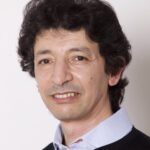Link to Pubmed [PMID] – 10192385
Link to HAL – pasteur-04036444
Link to DOI – 10.1038/7693
Nature Genetics, 1999, 21 (4), pp.363-369. ⟨10.1038/7693⟩
Using a candidate gene approach, we identified a novel human gene, OTOF, underlying an autosomal recessive, nonsyndromic prelingual deafness, DFNB9. The same nonsense mutation was detected in four unrelated affected families of Lebanese origin. OTOF is the second member of a mammalian gene family related to Caenorhabditis elegans fer-1. It encodes a predicted cytosolic protein (of 1,230 aa) with three C2 domains and a single carboxy-terminal transmembrane domain. The sequence homologies and predicted structure of otoferlin, the protein encoded by OTOF, suggest its involvement in vesicle membrane fusion. In the inner ear, the expression of the orthologous mouse gene, mainly in the sensory hair cells, indicates that such a role could apply to synaptic vesicles.

